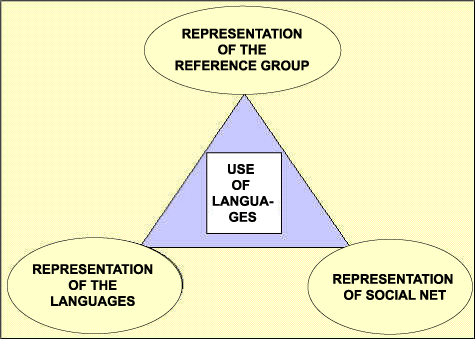
| Sociolingüística catalana |
| The evolution of the uses and social representation of the languages in Catalonia (1993-2000), by Ernest Querol | ||||
| CONTINUA |
These terms mean approximately what they suggest us at first sight: normal = 'habitual', separation = 'breakage' from were it was habitual. Warp = 'divergence' and compromise = 'convergence' with that different from itself. We can say that the warp fact will act when the speaker has a representation, a perception, more favourable from language B, this means, from the different language at the normal situation (A): so it produces, a warp respect what is habitual. About the compromise fact, we can say that it will act when the speaker has a different social net to the first speaking language, and a favourable perception of this other social net. With such a thing, convergence is possible (the compromise): speaking the language of the other. We will globally comment on our proposal of isomorphism: the attractions will correspond to the representation that the speakers make on the reference groups. Each language is situated on an extreme -as we have seen on table 2– so, these will be the two poles that attract the speakers to one side or the other. In this frame, the second fact, the one of warp will correspond to the social representation of language B (this means, the way how the speakers conceive it positively) that will make the attraction incline to the side of this language. And finally, will also act as the compromising fact (or "butterfly") that will be the positive representation of the social net from its second language and will influence upon the intention of convergence with the speakers of this language. Therefore, the isomorphism that we have arrived to lets us delimit: 1. -The number of variables that take part in the replacement process. 2. -The characteristics of these variables. 3. -New aspects: Realise that there is another language, that is not A or B (7). 4. -The consideration of four type of speakers: monolingual in L1, bilingual +L1 that L2, bilingual L1 / L2, bilingual +L2 that L1, monolingual L2. 5. - The reference group as a central settlement of the process of linguistic replacement structure that coincides with the theory of social representations. Definitively, our proposal of a theoretical model to study the uses of languages (dependent variable) related to the following independent variables: the social representations of the language, the groups of reference and the social nets. Let us see in the following table. Table 4. Relationship between the independent variables and the dependant variables (the use of languages)
The relations between all these facts are part of the hypothesis that we aimed to corroborate. Take note that the table wants to show us is the self-alimentation between all the variables. As we have already seen, in this research we are comparing the evolution of the results from the investigation of 1993, with the ones just obtained in October 2000. The method used for the research has been the inquiry, mainly because we wanted to compare the results that we arrived to with the concept of linguistic attitude and these were always quantitative. The sample has been in both occasions representative from the students around 16 years old from all over Catalonia. (Second of BUP at 1993, and first of batxillerat in 2000), from public to private schooling. Within this field, the sample was divided depending on the type of agglomeration (Barcelona/suburbs/urban/half rural), depending on the social extraction, and depending on the linguistic orientation of the centre. The details have been picked up from the same High schools, where we had already given the questionnaire out in 1993. And they have been taken from the 432 inquiries obtained in 1993, and the 443 from the year 2000, where the reliability has always been very high: they have surpassed 0.9767 in both of them. Referring to the treatment of statistics, we realise it from the habitual packet of the social science investigation, the Statistical Package of Social Science (SPSS) in it’s 8.0 version (registered software). We apply to the results of fieldwork the analysis of frequencies and the percentage of each variable (bi-variable analysis) and the multivariable analysis: Discriminate analysis and multiple regression. We also use a new method of induction techniques by graphs, SIPINA: Interactive System for the Processes of Investigation Non-Ramificated proposed by Rakotomalala (1997 and 2000), that we will comment at point Nr. 4.2.2. |
